Related Research Articles

The staged combustion cycle is a power cycle of a bipropellant rocket engine. In the staged combustion cycle, propellant flows through multiple combustion chambers, and is thus combusted in stages. The main advantage relative to other rocket engine power cycles is high fuel efficiency, measured through specific impulse, while its main disadvantage is engineering complexity.

The RD-170 is the world's most powerful and heaviest liquid-fuel rocket engine. It was designed and produced in the Soviet Union by NPO Energomash for use with the Energia launch vehicle. The engine burns kerosene fuel and LOX oxidizer in four combustion chambers, all supplied by one single-shaft, single-turbine turbopump rated at 170 MW (230,000 hp) in a staged combustion cycle.

The NK-33 and its vacuum-optimized variant, the NK-43, are rocket engines developed in the late 1960s and early 1970s by the Kuznetsov Design Bureau for the Soviet space program's ill-fated N1 Moon rocket. The NK-33 is among the most powerful LOX/RP-1 powered rocket engines ever built, noted for its high specific impulse and low structural mass.

NPO Energomash "V. P. Glushko" is a major Russian rocket engine manufacturer. The company primarily develops and produces liquid propellant rocket engines. Energomash originates from the Soviet design bureau OKB-456, which was founded in 1946. NPO Energomash acquired its current name on May 15, 1991, in honor of its former chief designer Valentin Glushko.
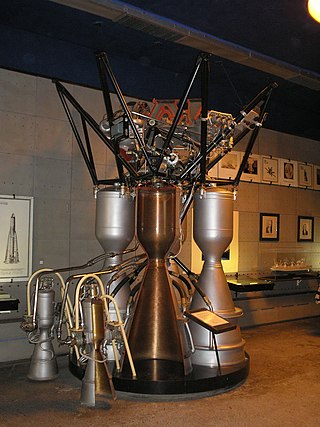
The RD-107 and its sibling, the RD-108, are a type of rocket engine used on the R-7 rocket family. RD-107 engines are used in each booster and the RD-108 is used in the central core. The engines have four main combustion chambers and either two (RD-107) or four (RD-108) vernier chambers.
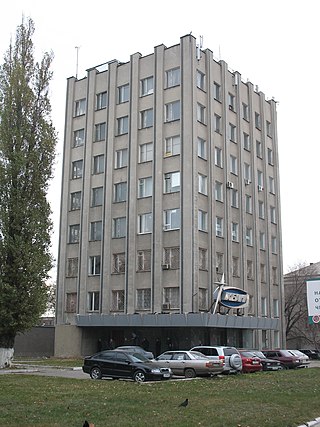
Chemical Automatics Design Bureau (CADB), also KB Khimavtomatika, is a Russian design bureau founded by the NKAP in 1941 and led by Semyon Kosberg until his death in 1965. Its origin dates back to a 1940 Moscow carburetor factory, evacuated to Berdsk in 1941, and then relocated to Voronezh city in 1945, where it now operates. Originally designated OKB-296 and tasked to develop fuel equipment for aviation engines, it was redesignated OKB-154 in 1946.

The RD-191 is a high-performance single-combustion chamber rocket engine, developed in Russia and sold by Roscosmos. It is derived from the RD-180 dual-combustion chamber engine, which itself was derived in turn from the four-chamber RD-170 originally used in the Energia launcher.
RD-0410 was a Soviet nuclear thermal rocket engine developed by the Chemical Automatics Design Bureau in Voronezh from 1965 through the 1980s using liquid hydrogen propellant. The engine was ground-tested at the Semipalatinsk Test Site, and its use was incorporated in the Kurchatov Mars 1994 crewed mission proposal.

The RD-0124 is a rocket engine burning liquid oxygen and kerosene in an oxygen-rich staged combustion cycle, developed by the Chemical Automatics Design Bureau in Voronezh. RD-0124 engines are used on the Block I stage used on Soyuz-2.1b and Soyuz-2.1v. A variant of the engine, the RD-0124A, is used on the Angara rocket family's URM-2 upper stage.
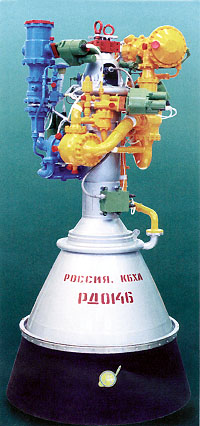
The RD-0146 is a liquid-fuel cryogenic rocket engine developed by KBKhA Kosberg in Voronezh, Russia.
The RD-120 is a liquid upper stage rocket engine burning RG-1 and LOX in an oxidizer rich staged combustion cycle with an O/F ratio of 2.6. It is used in the second stage of the Zenit family of launch vehicles. It has a single, fixed combustion chamber and thus on the Zenit it is paired with the RD-8 vernier engine. The engine was developed from 1976 to 1985 by NPO Energomash with V.P. Radovsky leading the development. It is manufactured by, among others, Yuzhmash in Ukraine.

The RD-0110 is a rocket engine burning liquid oxygen and kerosene in a gas generator combustion cycle. It has four fixed nozzles and the output of the gas generator is directed to four secondary vernier nozzles to provide attitude control for the stage. It has an extensive flight history with its initial versions having flown more than 64 years ago.
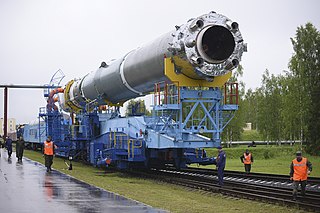
The RD-0110R is a rocket engine burning kerosene in liquid oxygen in a gas generator combustion cycle. It has four nozzles that can gimbal up to 45 degrees in a single axis and is used as the vernier thruster on the Soyuz-2.1v first stage. It also has heat exchangers that heat oxygen and helium to pressurize the LOX and RG-1 tanks of the Soyuz-2.1v first stage, respectively. The oxygen is supplied from the same LOX tank in liquid form, while the helium is supplied from separate high pressure bottles.
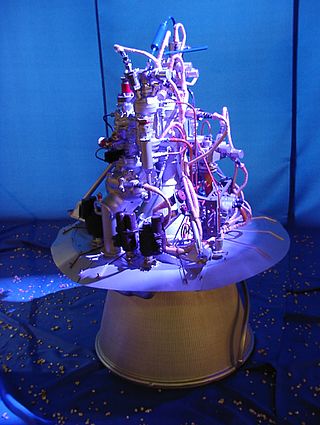
The RD-0109 is a rocket engine burning liquid oxygen and kerosene in a gas generator combustion cycle. It has single nozzle and is an evolution of the RD-0105. It was the engine used on the Vostok Block-E that launched Yuri Gagarin to orbit.
The RD-0214 (Russian: Ракетный Двигатель-0214 [РД-0214], romanized: Raketnyy Dvigatel-0214, lit. 'Rocket Engine 0214', GRAU index: 8D811) is a vernier thruster rocket engine burning unsymmetrical dimethylhydrazine (UDMH) fuel with dinitrogen tetroxide (N2O4) oxidizer in a gas-generator cycle. It has four nozzles that can each gimbal 45 degrees in plane to provide thrust vectoring control to the RD-0212 propulsion module of Proton rocket's third stage. It is a revised version of the RD-0207 (Russian: РД-0214, GRAU index: 8D67).
Voronezh Mechanical Plant is a Russian engine and heavy machinery manufacturing plant. It is located in the city of Voronezh, in the Voronezh Oblast.

The Soyuz-7 or Amur is a partially-reusable, methane–fueled, orbital launch vehicle currently in the design concept stage of development by the Roscosmos State Corporation in Russia. The preliminary design process began in October 2020, with operational flights planned for no earlier than 2028. Amur is intended to substitute for the existing Soyuz-2, at a much lower per launch cost.

Raptor is a family of rocket engines developed and manufactured by SpaceX. It is the third rocket engine in history designed with a full-flow staged combustion (FFSC) fuel cycle, and the first such engine to power a vehicle in flight. The engine is powered by cryogenic liquid methane and liquid oxygen, a mixture known as methalox.

M10 is a liquid-fuel upper-stage rocket engine in development by Avio on behalf of European Space Agency for use on Vega E. The engine, initially known as LM10-MIRA, was a derivation of the existing Russian RD-0146 engine and result of a past collaboration between Avio and Chemical Automatics Design Bureau (KBKhA) ended in 2014 after the escalation of the Russo-Ukrainian conflict and consequent economic sanctions. On May 6, 2022 engine testing campaign started at Salto di Quirra, Sardinia, with consequent maiden flight on a Vega-E launcher expected by 2026 from Guiana Space Centre.
The RD-0126 "Yastreb" was a liquid-fuel cryogenic rocket engine burning liquid hydrogen and liquid oxygen, developed by KBKhA Kosberg in Voronezh, Russia. The RD-0126 variant had a conventional de Laval nozzle, while the RD-0126E (РД-0126Э) was designed and constructed with an expansion-deflection nozzle. Both variants were designed to produce 39.2 kN (8,812.5 lbf) of thrust.
References
- ↑ "ДВИГАТЕЛЬ РД-0162". Archived from the original on 5 September 2019.
- ↑ РАБОЧИЕ ПРОЦЕССЫ В РАКЕТНОМ ДВИГАТЕЛЕ МАЛОЙ ТЯГИ НА ГАЗООБРАЗНЫХ КОМПОНЕНТАХ ТОПЛИВА КИСЛОРОД И МЕТАН, mai.ru
- ↑ "Новейший кислородно-метановый двигатель прошёл испытания". pp. 3DNews. Archived from the original on 19 February 2017.
- ↑ ""Энергомаш": создание нового двигателя в США стимулирует нас к развитию". RIA Novosti. Archived from the original on 21 October 2017.
- ↑ "КБХА. ЗАВЕРШЕНА РАЗРАБОТКА ЭКСКИЗНОГО ПРОЕКТА НОВОГО КИСЛОРОДНО-МЕТАНОВОГО ДВИГАТЕЛЯ ТЯГОЙ 85 ТОНН". Archived from the original on 1 September 2018.
- ↑ "Глава НПО "Энергомаш": постепенно возвращаемся к переговорам с зарубежными партнерами". TASS. Archived from the original on 28 August 2020.
- ↑ "В ВЦРД испытана штатная система зажигания кислородно-метанового двигателя". 24 December 2021. Archived from the original on 24 December 2021.
